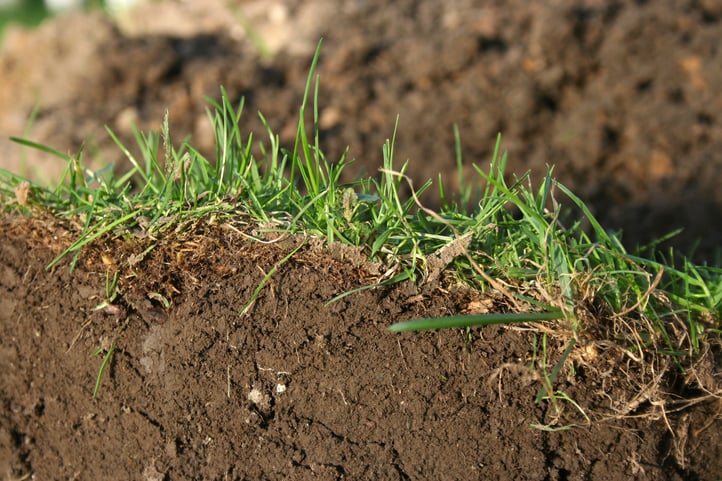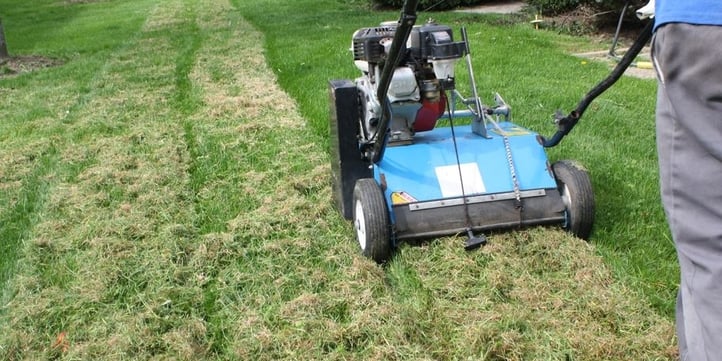
A little bit of thatch is perfectly fine for your lawn. An acceptable amount helps protect the crown of the grass plant and helps prevent soil compaction, but it's a different story once there's too much of it.
What is Thatch?
Lawn thatch is a tight, fibrous layer of dead, living, and decaying organic matter. Thatch primarily consists of stems, crowns, and shoot growth of the grass, which develops above the soil surface and accumulates when the rate of shoot growth exceeds the rate that the above ground parts of the plants decompose.
When this happens, the lawn is left with an excessive thatch layer that continues to accumulate, becoming more and more undesireable for your lawn.
Why Too Much Thatch Is A Problem
When left untreated, too much thatch can be detrimental to the success of your lawn. Excessive thatch is not a problem you want to have, because;
- It reduces the movement of air, sun, water and fertilizers
- It creates a perfect environment for increased insect and disease presence, as turf insects like chinch bugs live and feed in the thatch
- Thatch harbors disease causing organisms
- When thatch dries out it repels water, which in turn can cause Localized Dry Spot (LDS)
- Excessive thatch makes turf very prone to mower scalping
- It decreases heat, drought, and cold tolerance
- It reduces the effectiveness of control products. Control products bind to the thatch and are not able to reach target areas.
/chinchcheck_twitter.png?width=722&height=361&name=chinchcheck_twitter.png)
Do You Have Too Much Thatch?
A thatch layer more than half an inch thick is typically called excessive. Without examining the thatch with your own eye, there are a few symptoms that might suggest you have a little more thatch than you need, including;
- Shallow roots
- Poor growth and turf colour
- Insect infestation (particularly chinch bugs)
- Drought stress (even during irrigation)
Options For Removing Excess Thatch
Core Aeration
An annual aeration can do a wealth of good for your lawn, including helping to remove excess thatch. When an aeration is performed, small cores of soil (and thatch) are removed from the lawn with an aeration machine, and are then left on the lawn to become reincorporated. The process removes some of the thatch with each soil core, which in turn helps break down the excessive thatch layer.
This is the best option for lawns that have more than half an inch of thatch, but not more than 3 inches.
/aerate-annually-twitter.jpg?width=722&height=361&name=aerate-annually-twitter.jpg)
Power Raking
For lawns that have more than an inch of thatch, power raking is a gentle option to remove it. Using a dethatching machine, fixed knife type blades are set to high, just skimming the surface and slicing the thatch instead of ripping it out.
Unlike dethatching, power raking doesn't cause extensive damage, so the lawn recovers rapidly and maintains its density.

Dethatching
This process is only recommended for lawns with an extremely thick thatch layer, generally more than 3 inches. Dethatching involves the use of flail type blades that are designed to rip out excessive thatch. The dethatching machine is set low so that the blades reach into the surface of the soil.
Since dethatching causes a lot of damage, it creates a lawn that is thin, brown, and beat up. Because of this, we strongly recommend combining our Dethatching service with Overseeding or Slitseeding, as well as an application of Topdressing.

Have your local lawn care expert assess the thatch situation in your lawn so they can recommend the best course of action.
Follow us on Facebook or Pinterest for more lawn care tips and tricks!






/chinchcheck_twitter.png?width=722&height=361&name=chinchcheck_twitter.png)
/aerate-annually-twitter.jpg?width=722&height=361&name=aerate-annually-twitter.jpg)


